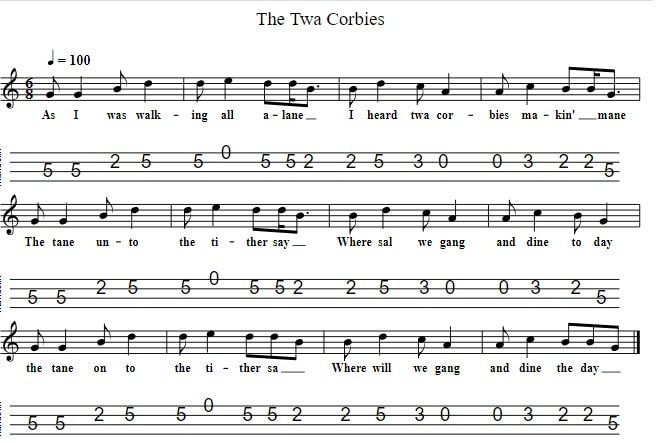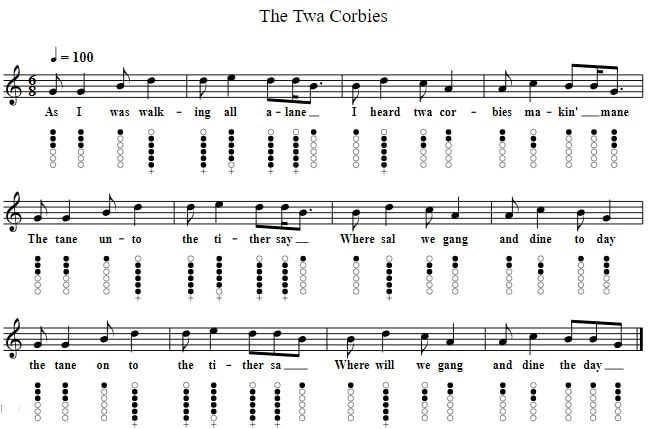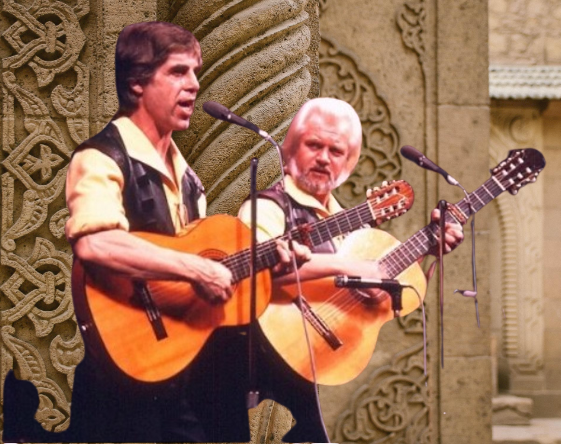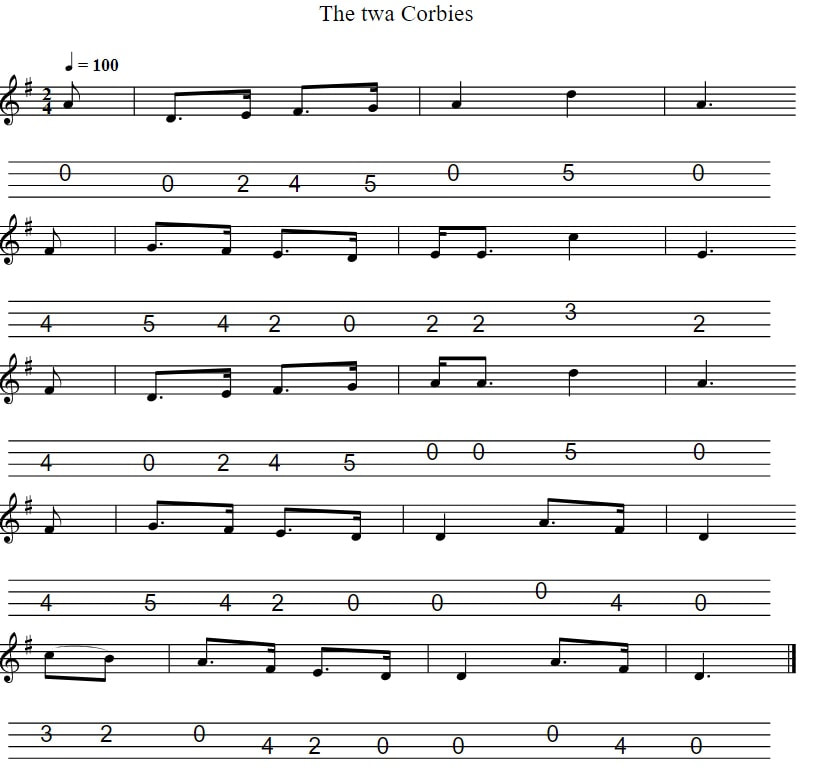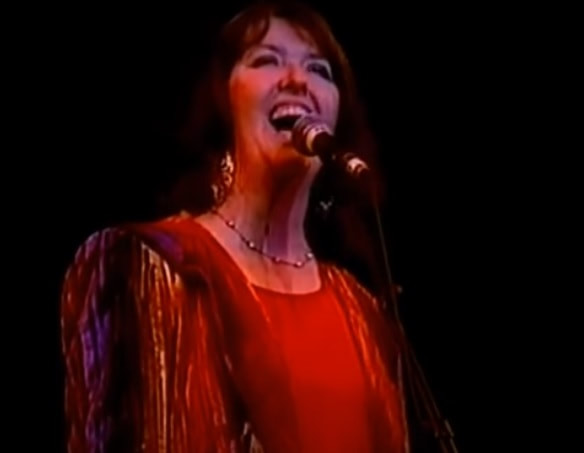The Twa Corbies The Corries Guitar Chords And Lyrics
This Scottish song like many before it started out as a poem and music was added much later, along with the Corries it was also recorded by Ewan McColl, Steeleye Span, Hamish Imlach to name a few. The sheet music and tin whistle notes are included. Back to the list of Corries Songs .The Twa Corbies Mandolin 4 String Banjo Tab is also included.
Introduction
The Twa Corbies is a traditional Scottish ballad that has been passed down through generations since the 18th century. It tells the story of two ravens, or corbies, who discuss their plans to feast on the body of a slain knight. The ballad is a haunting and macabre tale that has captured the imaginations of listeners for centuries. In this thesis, we will explore the origins, themes, and significance of The Twa Corbies song.
Origins and Evolution of The Twa Corbies
The exact origins of The Twa Corbies are unknown, as with many traditional ballads. However, it is believed to have originated in Scotland during the 18th century. The earliest known version of the ballad was published in 1772 in James Watson's Choice Collection of Scots Songs. Over the years, the ballad has been passed down through oral tradition and has evolved with each retelling.
The Twa Corbies has also been adapted and recorded by various artists, including Joan Baez, Pentangle, and The Chieftains. Each adaptation adds its own unique interpretation and style to the ballad, keeping it alive and relevant in modern times.
Themes in The Twa Corbies
The Twa Corbies is a ballad that is rich in symbolism and themes. The most prevalent theme is death and its inevitability. The two corbies, or ravens, are a symbol of death and serve as a reminder that death is always lurking nearby. The slain knight in the ballad represents the fragility and transience of life.
Another theme in The Twa Corbies is the cycle of life and death. The corbies discuss their plans to feast on the knight's body, highlighting the natural order of things where death leads to new life. This theme is also reflected in the repeated line 'And the corbies sang the lonesome tune,' which suggests that this is a song that has been sung many times before and will continue to be sung in the future.
The ballad also touches upon the theme of betrayal and the consequences of one's actions. The knight's fate is a result of his own actions, as he is betrayed by his own companions and left to die on the battlefield. This serves as a cautionary tale about the consequences of treachery and deceit.
Significance of The Twa Corbies
The Twa Corbies is more than just a traditional ballad; it holds a significant place in Scottish culture and literature. The ballad is a reflection of the harsh realities of life in Scotland during the 18th century, where death was a frequent occurrence due to wars, famine, and disease.
The Twa Corbies also serves as a commentary on human nature and the universal themes of life and death. Its enduring popularity and the numerous adaptations and interpretations of the ballad are a testament to its timeless relevance.
Furthermore, The Twa Corbies has played a role in preserving and promoting Scottish culture and heritage. The ballad has been passed down through generations and is still sung and enjoyed by many today. It has also been included in various collections of Scottish folk songs and has been used in literature and media, further cementing its significance in Scottish culture.
Conclusion
In conclusion, The Twa Corbies is a traditional Scottish ballad that has stood the test of time. Its origins may be shrouded in mystery, but its themes and significance are undeniable. The ballad's haunting melody and macabre lyrics continue to captivate listeners, making it a timeless piece of literature. Its enduring popularity and impact on Scottish culture and literature make The Twa Corbies a beloved and important song that will continue to be passed down for generations to come.
The Twa Corbies is a traditional Scottish ballad that has been passed down through generations since the 18th century. It tells the story of two ravens, or corbies, who discuss their plans to feast on the body of a slain knight. The ballad is a haunting and macabre tale that has captured the imaginations of listeners for centuries. In this thesis, we will explore the origins, themes, and significance of The Twa Corbies song.
Origins and Evolution of The Twa Corbies
The exact origins of The Twa Corbies are unknown, as with many traditional ballads. However, it is believed to have originated in Scotland during the 18th century. The earliest known version of the ballad was published in 1772 in James Watson's Choice Collection of Scots Songs. Over the years, the ballad has been passed down through oral tradition and has evolved with each retelling.
The Twa Corbies has also been adapted and recorded by various artists, including Joan Baez, Pentangle, and The Chieftains. Each adaptation adds its own unique interpretation and style to the ballad, keeping it alive and relevant in modern times.
Themes in The Twa Corbies
The Twa Corbies is a ballad that is rich in symbolism and themes. The most prevalent theme is death and its inevitability. The two corbies, or ravens, are a symbol of death and serve as a reminder that death is always lurking nearby. The slain knight in the ballad represents the fragility and transience of life.
Another theme in The Twa Corbies is the cycle of life and death. The corbies discuss their plans to feast on the knight's body, highlighting the natural order of things where death leads to new life. This theme is also reflected in the repeated line 'And the corbies sang the lonesome tune,' which suggests that this is a song that has been sung many times before and will continue to be sung in the future.
The ballad also touches upon the theme of betrayal and the consequences of one's actions. The knight's fate is a result of his own actions, as he is betrayed by his own companions and left to die on the battlefield. This serves as a cautionary tale about the consequences of treachery and deceit.
Significance of The Twa Corbies
The Twa Corbies is more than just a traditional ballad; it holds a significant place in Scottish culture and literature. The ballad is a reflection of the harsh realities of life in Scotland during the 18th century, where death was a frequent occurrence due to wars, famine, and disease.
The Twa Corbies also serves as a commentary on human nature and the universal themes of life and death. Its enduring popularity and the numerous adaptations and interpretations of the ballad are a testament to its timeless relevance.
Furthermore, The Twa Corbies has played a role in preserving and promoting Scottish culture and heritage. The ballad has been passed down through generations and is still sung and enjoyed by many today. It has also been included in various collections of Scottish folk songs and has been used in literature and media, further cementing its significance in Scottish culture.
Conclusion
In conclusion, The Twa Corbies is a traditional Scottish ballad that has stood the test of time. Its origins may be shrouded in mystery, but its themes and significance are undeniable. The ballad's haunting melody and macabre lyrics continue to captivate listeners, making it a timeless piece of literature. Its enduring popularity and impact on Scottish culture and literature make The Twa Corbies a beloved and important song that will continue to be passed down for generations to come.
[Am]As I was walking [G]all a[Am]lane,
[Am]I heard twa corbies [Em]makin a [Am]mane;
The [G]tane unto the [Dm]ither [Am]say,
"Whar [F]sall we gang [Dm]and [G]dine the-[Am]day
[Am]Whaur sail we gang [Dm]and [Em]dinn the [Am]day
In ahint yon auld fail dyke,
I wot there lies a new slain knight;
And nane do ken that he lies there,
But his hawk, his hound an his lady fair."
His hound is tae the huntin gane,
His hawk tae fetch the wild-fowl hame,
His lady's tain anither mate,
So we may mak oor dinner swate."
Ye'll sit on his white hause-bane,
And I'll pike oot his bonny blue een;
Wi ae lock o his gowden hair
We'll theek oor nest whan it grows bare."
Mony a one for him makes mane,
But nane sall ken whar he is gane;
Oer his white banes, whan they are bare,
The wind sall blaw for evermair."
[Am]I heard twa corbies [Em]makin a [Am]mane;
The [G]tane unto the [Dm]ither [Am]say,
"Whar [F]sall we gang [Dm]and [G]dine the-[Am]day
[Am]Whaur sail we gang [Dm]and [Em]dinn the [Am]day
In ahint yon auld fail dyke,
I wot there lies a new slain knight;
And nane do ken that he lies there,
But his hawk, his hound an his lady fair."
His hound is tae the huntin gane,
His hawk tae fetch the wild-fowl hame,
His lady's tain anither mate,
So we may mak oor dinner swate."
Ye'll sit on his white hause-bane,
And I'll pike oot his bonny blue een;
Wi ae lock o his gowden hair
We'll theek oor nest whan it grows bare."
Mony a one for him makes mane,
But nane sall ken whar he is gane;
Oer his white banes, whan they are bare,
The wind sall blaw for evermair."
